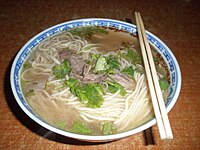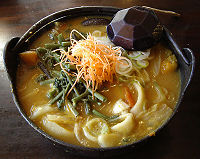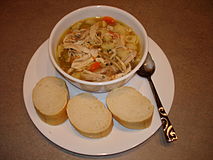List of noodle dishes


This is a list of notable noodle dishes. Noodles are a type of staple food[1] made from some type of unleavened dough which is rolled flat and cut into one of a variety of shapes. While long, thin strips may be the most common, many varieties of noodles are cut into waves, helices, tubes, strings, or shells, or folded over, or cut into other shapes. Noodles are usually cooked in boiling water, sometimes with cooking oil or salt added. They are often pan-fried or deep-fried. Noodles are often served with an accompanying sauce or in a soup.
Noodle dishes[]














- Ash reshteh—a type of aush (Iranian thick soup) featuring reshteh (thin noodles) and kashk (a dairy product, made from cooked or dried yogurt), commonly made in Iran and Azerbaijan
- Beshbarmak—a dish from Central Asian cuisine, usually made from finely chopped boiled meat with noodles and often served with chyk, an onion sauce
- Chow mein sandwich—typically consists of a brown gravy-based chow mein mixture placed between halves of a hamburger-style bun, and is popular on Chinese-American restaurant menus throughout southeastern Massachusetts and parts of neighboring Rhode Island
- Fried noodles—common throughout East Asia, Southeast Asia and South Asia, many varieties, cooking styles, and ingredients exist
- Guthuk—a noodle soup in Tibetan cuisine
- Instant noodle, or instant ramen, are noodles sold in a precooked and dried block with flavoring powder and/or seasoning oil; the flavoring is usually in a separate packet, although in the case of cup noodles, the flavoring is often loose in the cup
- Jajangmyeon—a Chinese-style Korean noodle dish topped with a thick sauce made of chunjang, diced pork, and vegetables; variants of the dish use seafood, or other meats
- Kesme—a type of egg noodle found in various Turkic countries, Iran and Afghanistan, also found in Turkish cuisine and is called erişte and kesme in modern standard Turkish; the word itself is a nominalisation of the verb to cut or to slice, referring to the slicing of the dough involved in preparing the noodles
- Khow suey—a noodle soup made of egg noodles and curried beef or chicken with coconut milk, served with a variety of contrasting condiments
- Laping—a spicy cold mung bean noodle dish in Tibetan cuisine, a street food also popular in some parts of Nepal
- Laghman—a Central Asian dish of pulled noodles, meat and vegetables
- Maggi goreng—a variation of Mamak-style mee goreng, using Maggi brand of instant noodles, prepared with hot water before stir-frying, instead of fresh yellow noodle
- Mee bandung Muar—the original and authentic version served in Muar district is still considered the best
- Meeshay—also spelt mi shay, mee shay, mee shei, is a Burmese cuisine dish of rice noodles with a meat sauce
- Mì Quảng—Vietnamese dish with rice noodles, meat, and herbs, commonly served with a broth, generally infused with turmeric
- Mie ayam—a common Indonesian dish of seasoned yellow wheat noodles topped with diced chicken meat (ayam)
- Mont di—a collective term for Burmese dishes made with thin rice noodles; the rice vermicelli is used fresh, as it ferments quickly in Myanmar's tropical climate
- Nan gyi thohk—a thoke salad dish in Burmese cuisine, made with thick round rice noodles mixed with specially prepared chicken curry and chili oil
- Noodle soup—a variety of soups with noodles and other ingredients served in a light broth, a common dish across East Asia, Southeast Asia and the Himalayan states of South Asia; various types of noodles are used, such as rice noodles, wheat noodles and egg noodles
- Ohn no khao swè—a Burmese dish consisting of wheat noodles in a curried chicken and coconut milk broth thickened with gram flour (chickpea flour)
- Pancit—in Filipino cuisine, pancit (also spelt pansít) are noodles and the dishes made from them, typically using rice noodles
- Pancit Malabon—its sauce has a yellow-orange hue, attributable to achuete (annatto seeds), shrimp broth, and flavor seasoned with patis (fish sauce for a complex umami flavor) and crab fat
- Saimin—a noodle soup dish common in the contemporary cuisine of Hawaii
- Silesian dumplings
- Singapore-style noodles—stir-fried cooked rice vermicelli, curry powder, vegetables, scrambled eggs and meat, most commonly chicken, beef, char siu pork, or prawns, yellow in colour
- Soto ayam
- Sukhothai rice noodles
- Thenthuk
- Thukpa
- Yaka mein
- Yakisoba
Burmese[]
- Baik kut kyee kaik
- Khauk swè (Khauk means fold and swè means pull. Literally that's how noodles are made like Hand pulled noodles)
- Khauk swè thoke
- Kya zan hinga
- Kyay oh
- Meeshay
- Mohinga
- Mont di
- Nan gyi thohk
- Ohn no khao swè
- Sigyet khauk swè
- Shan khauk swè
Bhutanese[]
Cambodian[]

- Kuy teav
- Num banh chok
- Mee sua
- Banh kanh
Chinese[]
There is a great variety of Chinese noodles, which vary according to their region of production, ingredients, shape or width, and manner of preparation. They are an important part of most regional cuisines within China, as well as in Taiwan, Singapore, and other Southeast Asian nations with sizable overseas Chinese populations.




- Ants climbing a tree
- Banmian
- Beef chow fun
- Beef noodle soup
- Cart noodle
- Chongqing noodles
- Chow mein
- Crossing the bridge noodles
- 宽粉 (Kuan fen noodles)
- Dan zai noodles
- Dandan noodles
- Drunken noodles
- Hokkien mee
- Hot and sour noodles
- Hot dry noodles
- Lanzhou beef lamian
- Liangpi
- Lo mein
- Lomi
- 火锅炖粉 (Huoguo dun fen)
- Luosifen
- Mee pok
- Millinge
- Noodles with tomato egg sauce
- Satay bee hoon
- Shanghai fried noodles
- Su-style noodle
- Ulmyeon
- Wonton noodles
- Yuntunmian
- Zhajiangmian
Hong Kong[]
- Wonton noodles
Indonesian[]



- Bakso
- Bakmi
- Banmian
- Bihun goreng
- Char kway teow
- I fu mi
- Kwetiau ayam
- Kwetiau goreng
- Kwetiau siram sapi
- Laksa
- Lakso
- Mi aceh
- Mi ayam
- Mi bakso
- Mi cakalang
- Mi caluk
- Mi celor
- Mi gomak
- Mi goreng
- Mi jawa
- Mi kari
- Mi kangkung
- Mi kering
- Mi koclok
- Mi kocok
- Mi kuah
- Mi pangsit
- Misoa
- Soto
- Soto mi
- Tekwan
Japanese[]

Japanese noodles are a staple part of Japanese cuisine. They are often served chilled with dipping sauces, or in soups or hot dishes.[2]
- Champon
- Hōtō
- Okinawa soba
- Ramen
- Shirataki noodles
- Sara udon
- Udon
- Sōmen
- Tensoba
- Toshikoshi soba
- Tsukemen
- Yaki udon
- Yakisoba
Korean[]
- Bibim guksu
- Japchae
- Janchi guksu
- Jatguksu
- Jjolmyeon
- Makguksu
- Naengmyeon
- Kalguksu
- Kongguksu
- Milmyeon
- Jjamppong
- Jjajangmyeon
- Ra-bokki
- Jjapaguri (ram-don)
Laotian[]
- Drunken noodles
- Khao poon
- Khao soi
- Feu (food)
- Lard na
- Phat si io
- Khao piak sen
Malaysian[]

- Banmian
- Char kway teow
- Curry Mee
- Duck soup noodles
- Hae mee
- Hokkien mee
- Laksa
- Lor mee
- Mee pok
- Mee siam
- Mi rebus
- Mie goreng
- Rice noodle roll
Nepalese[]
Philippine[]


- Batchoy
- Kinalas
- Lomi
- Mami
- Pancit canton
- Pancit choca
- Pancit bihon
- Pancit estacion
- Pancit luglug
- Pancit molo
- Pancit miki
- Pancit palabok
- Sopa de fideo
Singaporean[]

- Banmian
- Char kway teow
- Hae mee
- Hokkien mee
- Katong Laksa
- Mee pok
- Mee siam
- Mee Soto
- Mie goreng
- Mi rebus
- Satay bee hoon
- Singapore style noodles
- Vegetarian bee hoon
- Wonton noodles
Spanish[]
Fideo is the Spanish word for noodle. While in other Spanish-speaking countries fideo can refer to many kinds of pasta, in Spain the word is reserved for the short variety of vermicelli.[citation needed]
Taiwanese[]
- Oyster vermicelli
- Ta-a noodles
- Taiwanese beef noodle soup
Thai[]

- Drunken noodles
- Khao soi
- Mi krop
- Phat si io
- Kuy teav
- Nam ngiao
- Pad Thai
- Rat na
Tibetan[]
United States[]
- Chicken Riggies
- Chicken noodle soup
- Kraft Dinner

Chicken noodle soup, with bread
Hawaii[]
Vietnamese[]
- Bánh hỏi
- Bún bò Huế
- Bun cha
- Bún mắm
- Bún riêu
- Bún thịt nướng
- Bánh canh
- Cao lầu
- hủ tiếu
- Mì Quảng
- Pho

A simple pho dish
See also[]
- List of fried noodle dishes
- List of noodles
- List of instant noodle brands
- List of noodle restaurants
- List of ramen dishes
- List of pasta
- List of pasta dishes
References[]
- ^ 4,000-Year-Old Noodles Found in China
- ^ Sakui, S. (2009, July 1st). Somen: Chilled, the Japanese Noodles are a Summer Delight. Los Angeles Times. Retrieved January 9th, 2010
External links[]
 Media related to Noodle-based food at Wikimedia Commons
Media related to Noodle-based food at Wikimedia Commons Media related to Noodles by country at Wikimedia Commons
Media related to Noodles by country at Wikimedia Commons Media related to Noodles from China at Wikimedia Commons
Media related to Noodles from China at Wikimedia Commons Media related to Noodles from Indonesia at Wikimedia Commons
Media related to Noodles from Indonesia at Wikimedia Commons Media related to Noodles from Japan at Wikimedia Commons
Media related to Noodles from Japan at Wikimedia Commons Media related to Noodles from Korea at Wikimedia Commons
Media related to Noodles from Korea at Wikimedia Commons Media related to Noodle dishes of Laos at Wikimedia Commons
Media related to Noodle dishes of Laos at Wikimedia Commons Media related to Noodle dishes of Malaysia at Wikimedia Commons
Media related to Noodle dishes of Malaysia at Wikimedia Commons Media related to Noodle dishes of Thailand at Wikimedia Commons
Media related to Noodle dishes of Thailand at Wikimedia Commons Media related to Noodle dishes of Singapore at Wikimedia Commons
Media related to Noodle dishes of Singapore at Wikimedia Commons Media related to Noodles at Wikimedia Commons
Media related to Noodles at Wikimedia Commons
- Noodle dishes
- Lists of foods by ingredient









